Driving northeast from Rome, into deepest Lazio, you soon come across some places that could only be in Italy. Penny Wainwright takes the tour…
Photos by Penny Wainwright
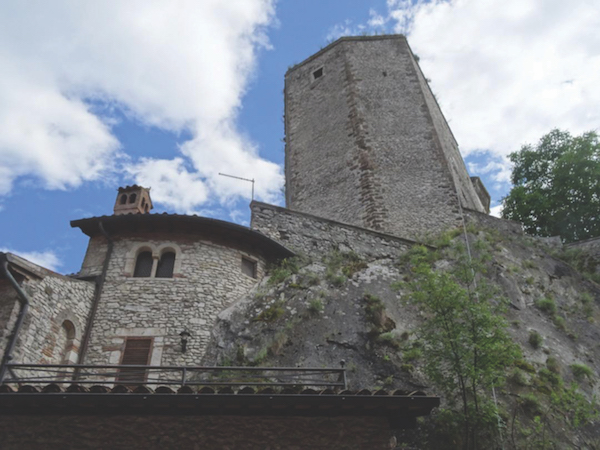
On the drive from Rome through the tree-covered hills of Lazio, on the shores of Lago Turano, is Castel di Tora, one the Borghi più belli d’Italia; and with the Monte Navegna and Monte Cervia nature reserve close by, it is indeed a picturesque spot, with a curious recent history. Built on a rocky outcrop, this medieval village is dominated by its 11th-century fortress tower, which is all that remains of the original castle. A river used to run through the valley, until 1936, when the Turano dam was built to provide water for hydro-electric power and the lake was created. Once the valley was flooded and farming was lost, the number of inhabitants dwindled from 1,000 to just 300 today. In the village I met the mayor, Ceserina d’Alessandro, and villagers in their traditional dress, including Rita, who owns a small shop in the village and is known as ‘Madame della Carpe’. Such is the bond of this close-knit community, Rita tells me the villagers are her family, as she now lives on her own. Local artist Elisabetta Catarno creates mosaics of native wildlife using shells collected from the lake’s shores and they adorn the walls of houses along the narrow streets of the village.
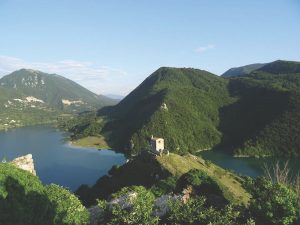
I travel by Jeep with the Park Guide to the nearby ghost town of Antuni, which dates back to the 15th century. It stands on Monte Antuni, a tiny peninsula of land jutting out into the lake. In 1944, an air raid intended to destroy the nearby bridge over the dam bombed the town out of existence. Palazzo del Drago sits at the heart of Antuni and some of it has recently been restored. A small museum has been installed with information about the local Monte Navegna e Monte Cervia Regional Nature Reserve and the creation of Lake Turano. Much of the nature reserve is covered in beech and chestnut forest, a natural habitat for wild boar, fox, deer, wolves and golden eagles. I spent my first night at the nearby Turano Resort by the shores of Lake Turano with wonderful views across the lake to Castel di Tora and Antuni.
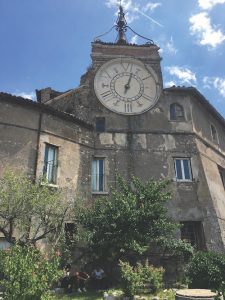
Nero’s summer residence
A 50-minute drive takes me to Subiaco, a small town on the River Aniene in the Mount Simbruini Natural Park. Nero commissioned a summer residence at Subiaco in 60 AD, consisting of three lakes created by dams on the River Aniene, with five marble buildings, bridges, waterfalls and pavilions. Sublaqeum, ‘under the lake’, was the name given to the villa and then later to the town. From the ruins of Nero’s villa is the 9th-century San Benedetto monastery, carved and built into the rockface. On the lower floors, frescoes showing the life of St Benedict follow the natural contours of the rocks. Sacro Specco is where young St Benedict spent three years in retreat. Of the 12 monasteries he created, only the Santa Scolastica monastery remains, as the rest were destroyed by earthquakes and invasions. There is also a unique portrait of St Francis, painted when he visited Subiaco, and St Benedict spent thirty years here before going to Montecassino, where he died.
The Cammino di San Benedetto covers 300 kilometres from his birthplace in Norcia to Montecassino. Near the monastery, a small wooden sign for the Larghetto di San Benedetto led along a track to the river and a small lake, with a waterfall creating a mist over the water. I could see the monastery high above it and it was a quiet place to reflect. A couple followed, carrying swimming costumes, and my guide told me it is a popular swimming pool.
In the town, the 11th-century Rocca dei Borgia di Subiaco is where the infamous Lucretia Borgia was born in 1480. It was the property of the church until 2015, when restoration work began and it opened for visitors. Inside there are frescoes and painted ceilings, some showing signs of deterioration. Outside is a large six-hour clock, as unlike modern clocks, it only needed to show the daylight hours.
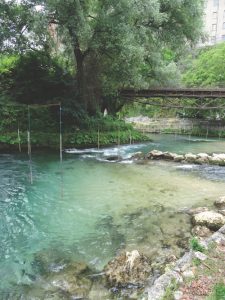
Museum of printing
The River Aniene runs through the town, with the Borgo dei Cartai, a museum of printing and paper making workshops, along the banks of the river. In the museum we were shown a page of the first book made in Italy using mobile characters, Cicero’s De Oratore, which was printed between 1465 and 1473. Traditional paper making involved rags being cut as small as possible to go into a wooden water-powered machine which hammered the rags, where, mixed with the water, they turned into a creamy substance. One hundred and fifty layers of paper would be placed into a press to drain off the water and then left to dry for two or three days. The resulting paper was rough, so stones were used to smooth the surface out. A coat of glue from boiled animal bones made the final result suitable to write on.
Getting hands-on, I dissolved fibre mixture to make a piece of paper for myself using the ancient techniques. It was great fun – I drained off the water from the mixture on a mesh, rolled it on felt to absorb excess water and hung it up to dry. I added a watermark to another piece of dried paper with a metal stamp to create a watermark, and finished it with a red wax seal. It was a special privilege to make paper as it would have been made so long ago. Also on the river, the Palio di San Lorenzo takes place on the 10th of August, covering three to four kilometres along the River Aniene. This Palio is not a horse race but a raft race along the river. Seven teams take part, with a blessing in the church, a historic procession with flags and banners down to the river and the teams making an pledge on the Ponte Sant’Antonio to do their best.
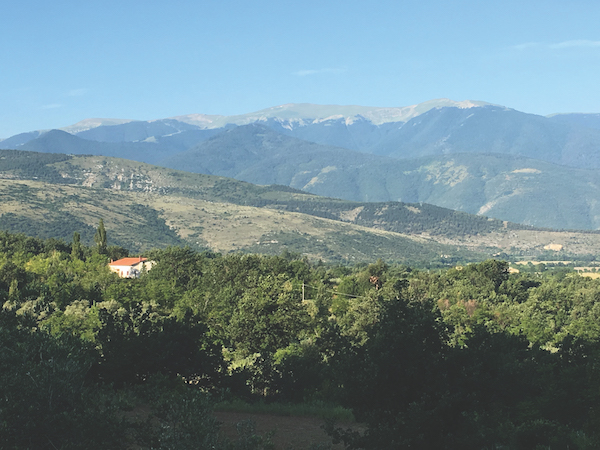
Late afternoon, I drive on into Abruzzo, stopping in the mediaeval village of Pacentro. This is another of Italy’s ‘most beautiful villages’. At La Tana della Volpe, I took part in a cooking class making gnocchi and pasta. The cook, Anna, had already cooked and prepared the potatoes ready to mix with flour and eggs. I watched as the ingredients were kneaded into a sausage shape. My job was to roll the mixture and cut into small cylinder shaped pieces. Then we moved on to the pasta, and as the inexperienced chefs cracked their eggs, there were shouts of dismay as eggs escaped from the flour onto the table. I enjoyed mixing and kneading the pasta dough and cutting it by hand, before using a pasta machine to make strands of fine tagliatelle. The reward for our hard work was to eat our pasta with meatballs and tomato sauce afterwards.
Flowers everywhere
For my final morning I went into Pacentro, admiring flowers everywhere on the houses, steps and narrow streets. Plaques on the houses represent the 15 contrade, or districts, of the town and surrounding villages, such as the Castello Contrada, which is the oldest neighbourhood. At the centre of village is the Piazza del Popolo, where the Chiesa Madre has the second tallest bell tower in the region. Piazza del Popolo is the town’s‘living room’ where the people come to meet, eat and children play. From here there are views across the Majella National Park, Mont Morrone and the Valle Peligna.
A village resident, Marlurita, lived in a two-roomed house until she died in 1978, aged 88. The house has remained untouched with a kitchen and bedroom, no windows, water, electricity or heating. It is a house of memories, allowing the younger generations of visitors to imagine the rigours of life of the Appenines in the past and to preserve the memories of those village traditions.
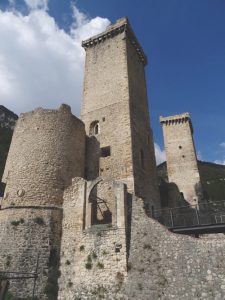
Defensive castles
Caldora Castle sits on Colle Castello and was part of a series of defensive castles dating back to the 10th century. The castle was triangular with one defensive tower, but over time was enlarged and two additional towers built. The castle has been owned by the Caldora, Orsini and Barberini families. Three of the towers remain and the castle has been partially restored allowing visitors access to the hall and the towers. From the highest tower there are wide reaching views across the hills and over the village.
I also met an Australian couple who had visited Pacentro and now own a holiday home near I Canaje. This is the old public laundry where the women would gather to wash their clothes on the stones. From the tower, I picked out the green, white and red painted rock on Colle Ardinghi, opposite the village. On the first Sunday of September, as part of the Festa della Madonna di Loreto, young men run barefoot from the rock to the church in a race known as the Corsa degli Zingari.
Before leaving, I was lucky enough to visit the last stonemason in Pacentro, Fernandino de Angelis. His grandfather, father and uncle were also famous stonemasons. Using a piece of Majella limestone he demonstrated his skills. With no family to pass on his knowledge and business to, it is sad to think his craft will be lost to Pacentro one day.
Regretfully I had to travel back to Rome and the airport, but despite a brief stay, I had seen so much of Lazio and Abruzzo’s charms which makes me keen to explore more of the National Parks and hillside villages – perhaps walking part of the San Benedetto Way next time.
Don’t miss our Lazio & Abruzzo travel guide for more info on the area
